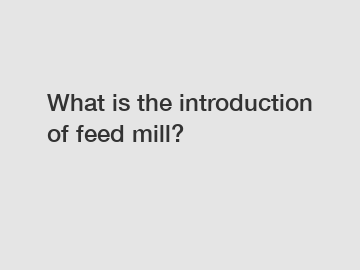What is the introduction of feed mill?
Importance of Feed Mills.
Feed mills play a crucial role in modern animal agriculture by providing balanced and nutritious feed to livestock. The feed produced in these facilities is formulated based on the specific dietary requirements of different animal species, including poultry, cattle, swine, and fish. Proper nutrition is essential for animals to grow efficiently, produce high-quality products (such as milk, meat, and eggs), and maintain their overall health.
Production Process.

The production process in a feed mill involves several steps, including receiving raw materials, grinding, mixing, pelleting, and packaging. Let's briefly discuss each of these steps:
Receiving Raw Materials: Feed mills receive various raw materials such as grains, oilseeds, by-products from food processing industries, vitamins, minerals, and additives. These raw materials are carefully selected and tested for quality before being used in feed formulation.
Grinding: The next step involves grinding the raw materials to reduce their particle size and improve their digestibility. Grinding helps in uniform mixing of ingredients and enhances the overall nutritional value of the feed.
Mixing: Once the raw materials are ground, they are mixed together in proper proportions to create a balanced feed formulation. The mixing process ensures that all nutrients are evenly distributed throughout the feed, providing animals with a consistent and complete diet.
Pelleting: In some feed mills, the mixed feed is pelleted to form uniform pellets that are easy to handle, store, and transport. Pelleting can improve feed efficiency, reduce waste, and enhance the digestibility of nutrients.
Packaging: The final step in the feed production process is packaging the finished feed into bags or bulk containers for distribution to farmers, feed stores, and livestock producers. Proper packaging helps maintain the quality and freshness of the feed until it reaches the end-users.
Quality Control and Safety.
Feed mills adhere to strict quality control measures to ensure that the feed produced meets the nutritional requirements of animals and is safe for consumption. Quality control involves testing raw materials, monitoring the production process, and analyzing the finished feed for nutrient content and contaminants. Feed mills also follow food safety guidelines to prevent contamination and ensure the health and safety of animals and consumers.
Conclusion.
In conclusion, feed mills play a vital role in animal agriculture by producing high-quality, nutritious feed for livestock. These facilities are equipped with modern machinery and technology to efficiently process raw materials and formulate balanced diets for different animal species. By providing optimal nutrition to animals, feed mills contribute to the overall productivity, health, and welfare of livestock globally.
Contact Us.
If you have any questions about feed mills or need assistance with animal feed production, please feel free to contact us. Our team of experts is here to help you with your feed mill needs.
Want more information on feed cleaner machine, animal feed coating machine, animal feed dust collecting machine? Feel free to contact us.

Comments